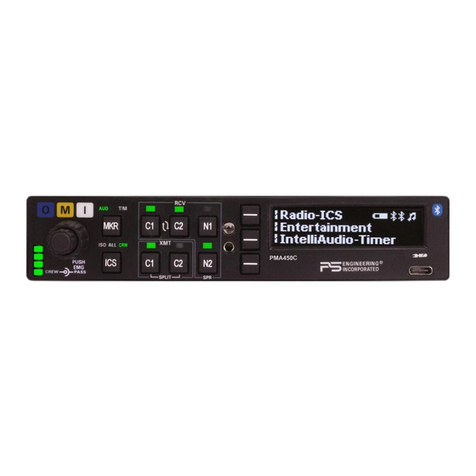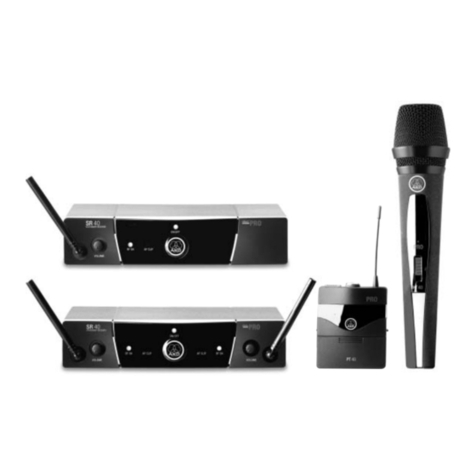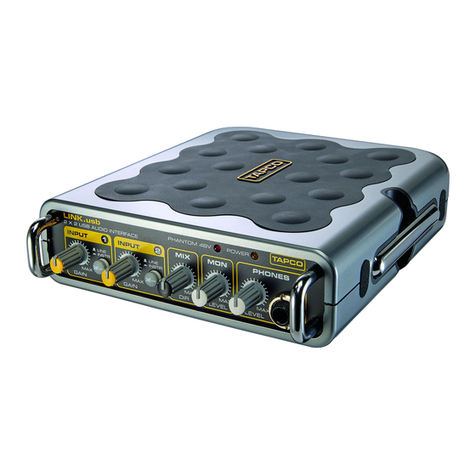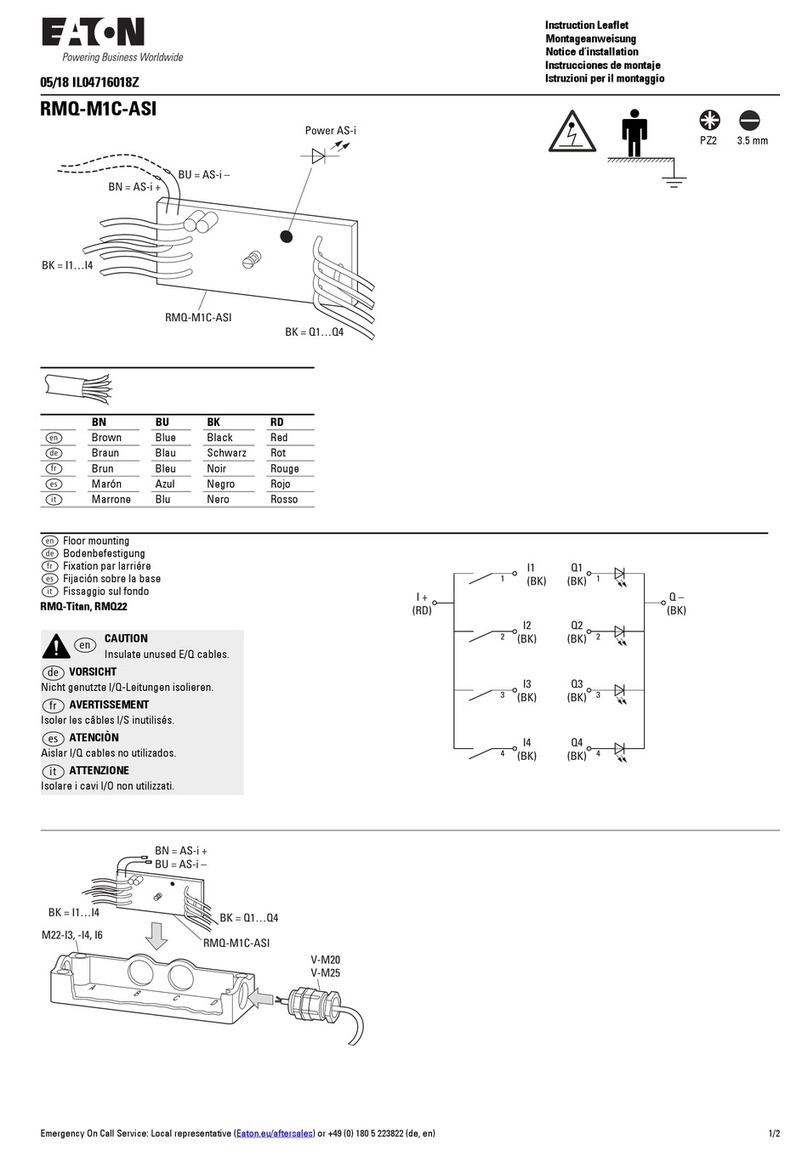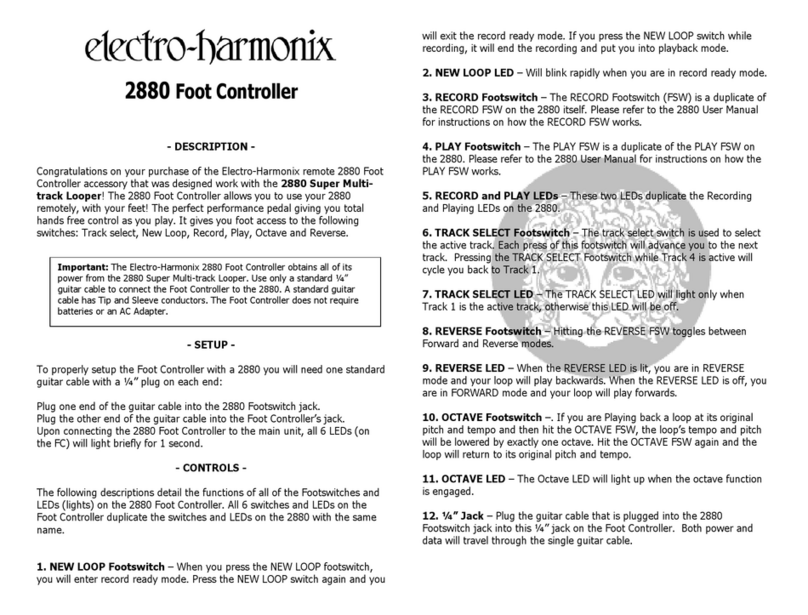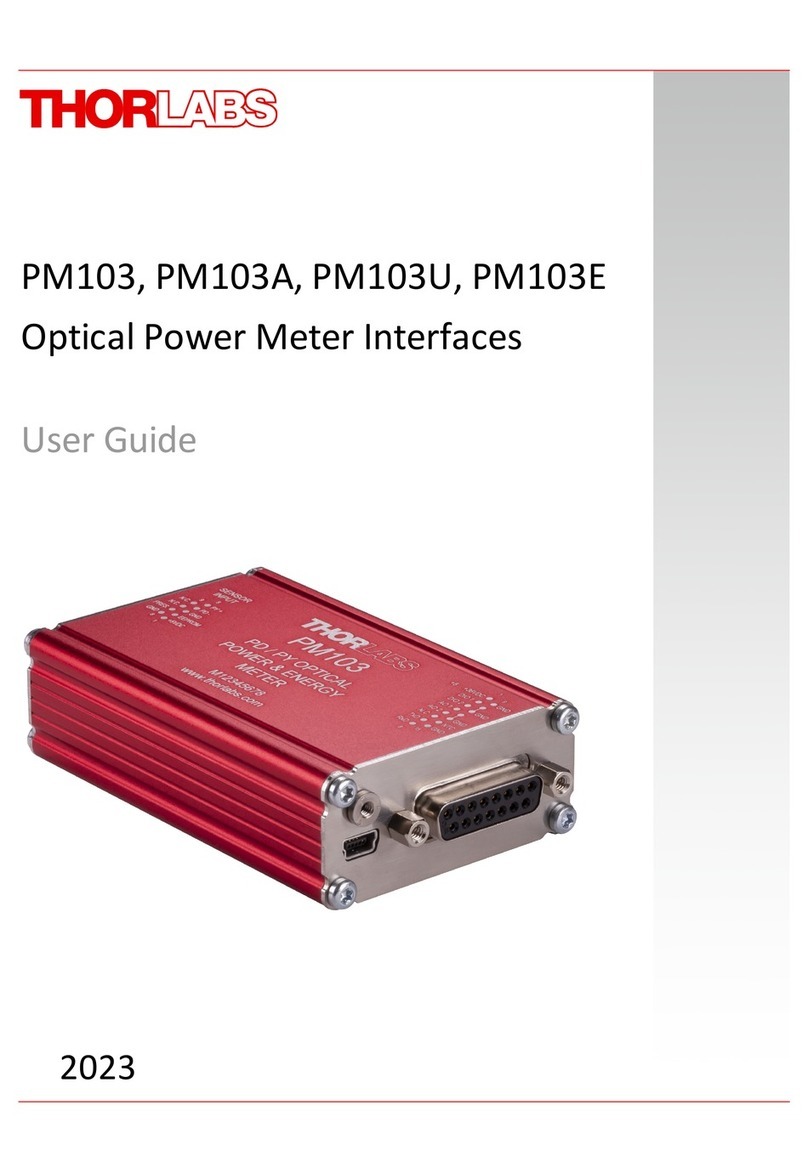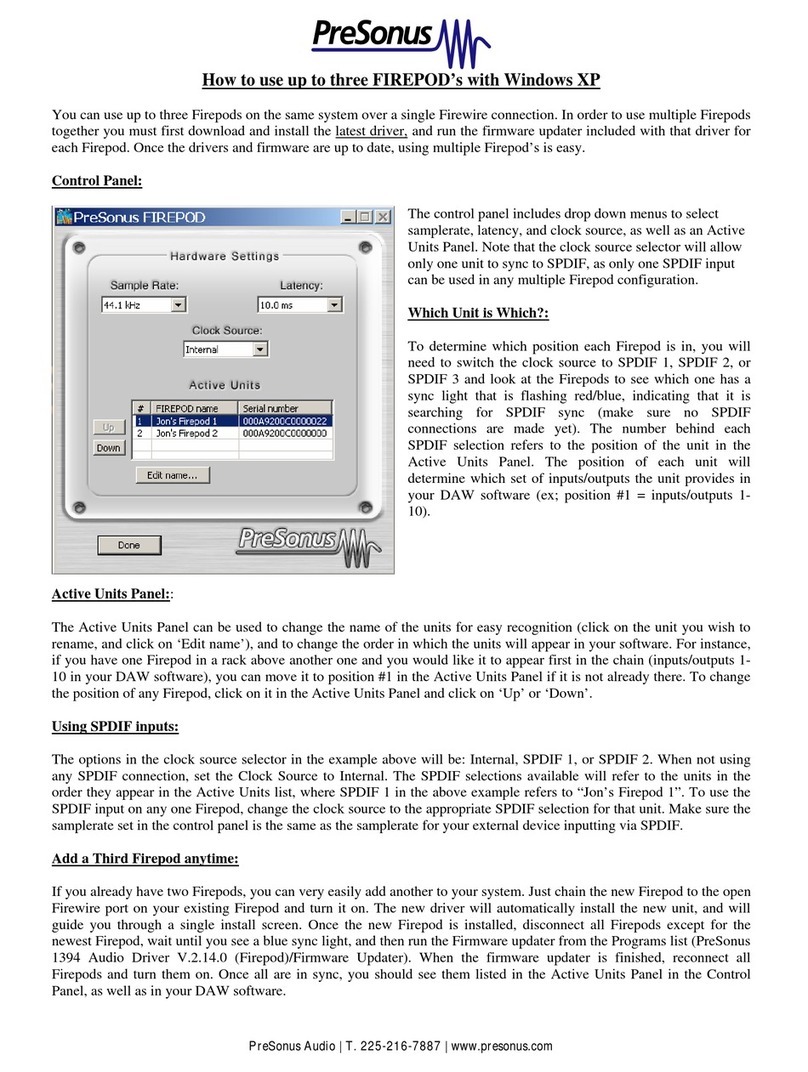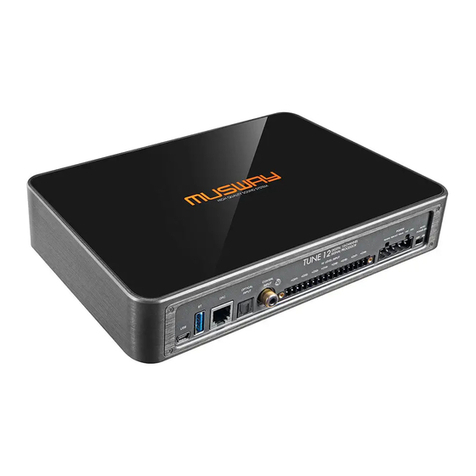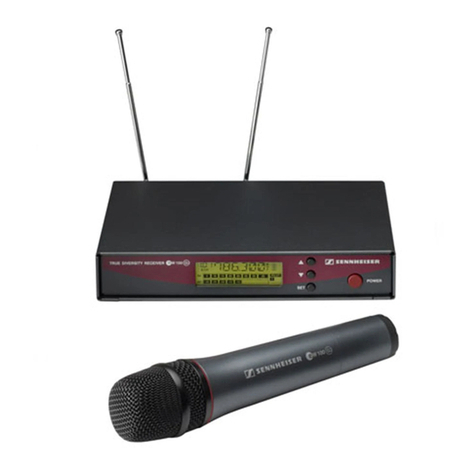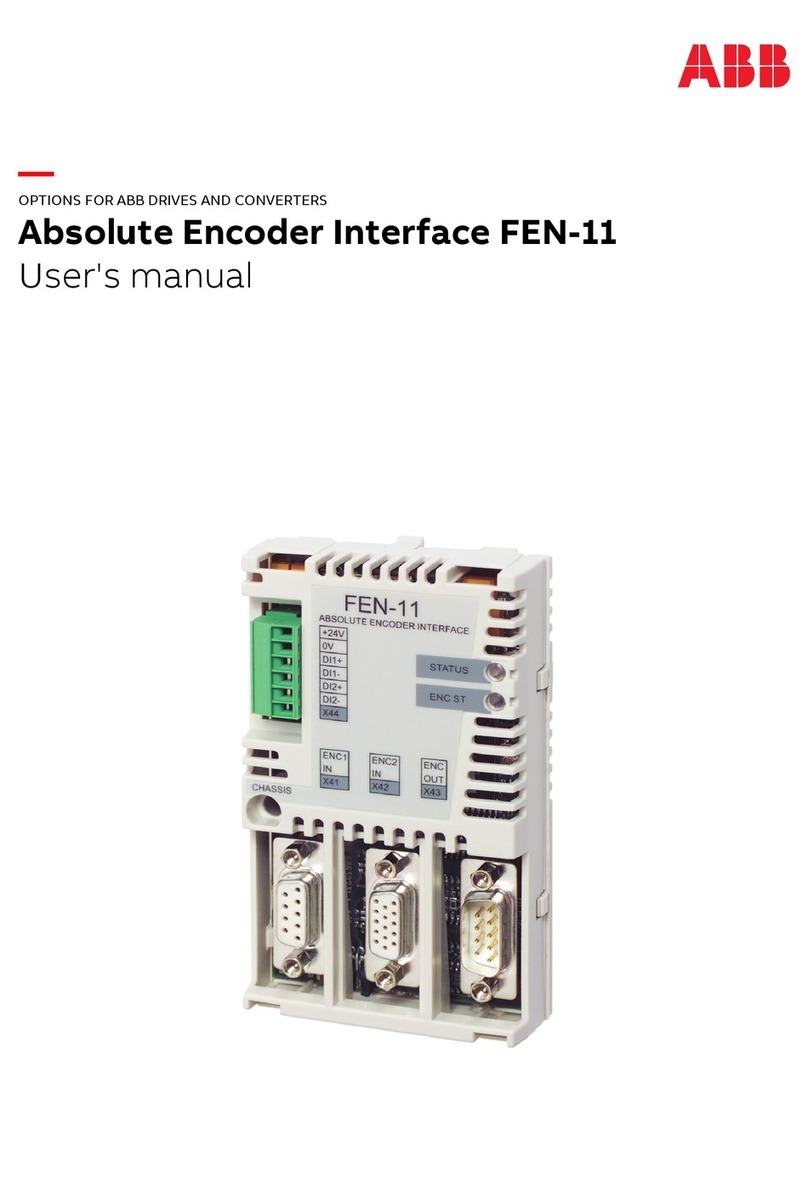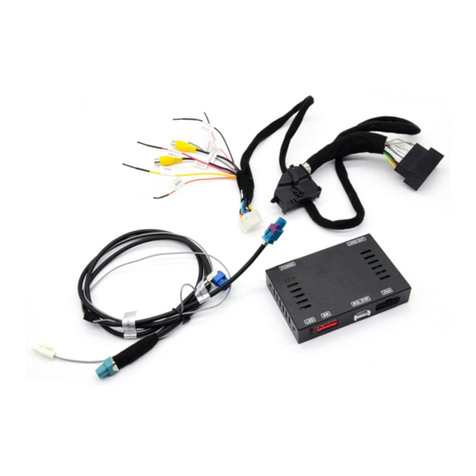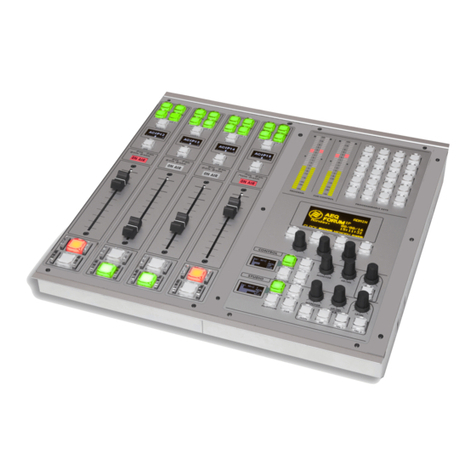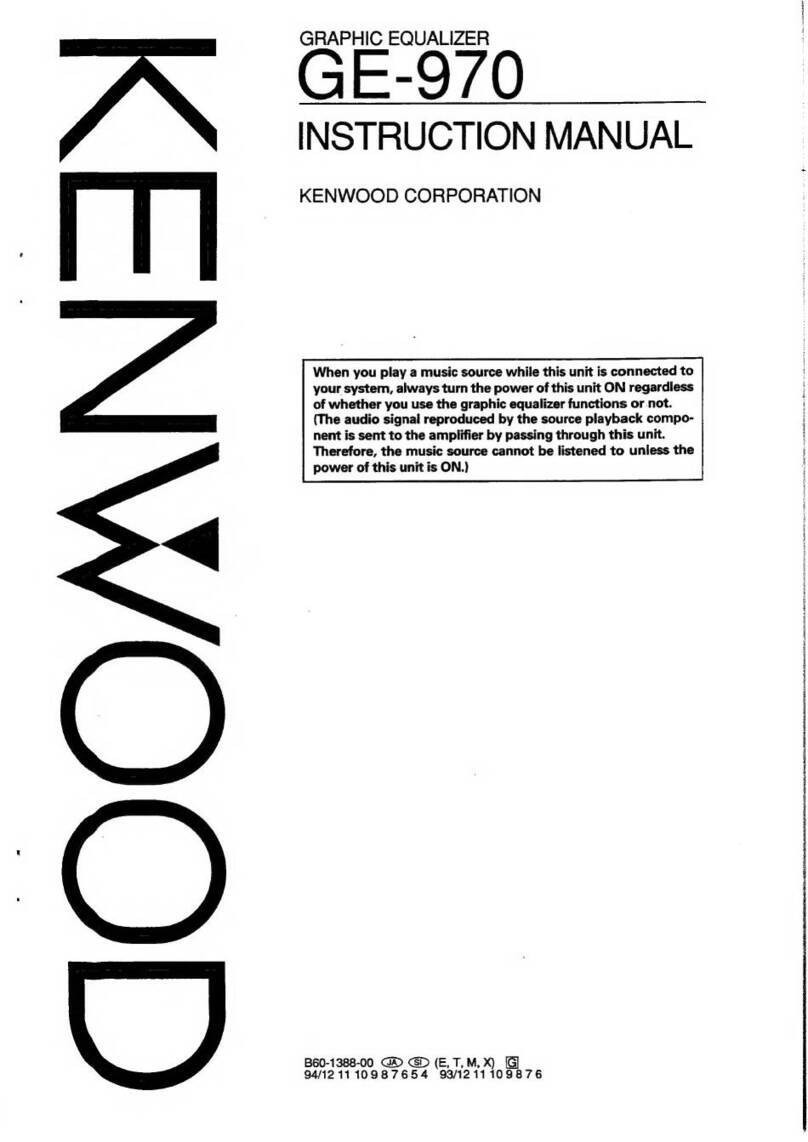PS Engineering PAC45 System With MultiTalker User guide

9800 Martel Road
Lenoir City, TN 37772
www.ps-engineering.com
PAC45
Special Mission Audio Controller System with
MultiTalker™and IntelliVOX®
Document P/N 200-045-0000
Rev. 7, May 2019
Audio Control System with MultiTalker Technology
High-fidelity Stereo Intercom
System Installation and Operation Manual
FAA - TSO C139a
Patented under one or more of the following;
No. 4,941,187; 5,903,227; 6,160,496 and 6,493,450, 7,391,877
PS Engineering, Inc. 2019 ©
Copyright Notice
Any reproduction or retransmittal of this publication, or any portion thereof, without the expressed written permission of PS En-
gineering, Inc. is strictly prohibited. For further information, contact the Publications Manager at PS Engineering, Inc., 9800
In certified aircraft, warranty is not valid unless this product is installed by an
Authorized PS Engineering dealer.

Table of Contents
Section I –GENERAL INFORMATION..................................1-1
1.1 INTRODUCTION............................................................................................................................................1-1
1.1.1 LIMITATIONS ........................................................................................................................ 1-1
1.2 SCOPE ..........................................................................................................................................................1-1
1.3 EQUIPMENT DESCRIPTION ...........................................................................................................................1-2
1.4 APPROVAL BASIS –PENDING-...........................................................................................................................1-2
1.1.2 LIMITATIONS ........................................................................................................................ 1-2
1.5 SPECIFICATIONS...........................................................................................................................................1-3
1.6 EQUIPMENT SUPPLIED .................................................................................................................................1-4
1.8 CONFIGURATIONS..............................................................................................................................................1-7
1.9 LICENSE REQUIREMENTS..............................................................................................................................1-8
Section II - INSTALLATION .........................................2-1
2.1 GENERAL INFORMATION..............................................................................................................................2-1
2.1.1 SCOPE ............................................................................................................................... 2-1
2.1.2 CERTIFICATION REQUIREMENTS............................................................................................... 2-1
2.2 UNPACKING AND PRELIMINARY INSPECTION .............................................................................................................2-1
2.3 EQUIPMENT INSTALLATION PROCEDURES .................................................................................................................2-1
2.3.1 COOLING REQUIREMENTS....................................................................................................... 2-1
2.3.2 MOUNTING REQUIREMENTS ................................................................................................... 2-1
2.3.3 AUDIO CONTROLLER CONNECTOR ASSEMBLY ............................................................................. 2-2
2.4 CABLE HARNESS WIRING.....................................................................................................................................2-3
2.4.1 ELECTRICAL NOISE................................................................................................................. 2-3
2.4.2 POWER ............................................................................................................................... 2-4
2.4.3 AUDIO CONTROLLER INTERFACE............................................................................................... 2-4
2.4.4 TRANSMIT INTERLOCK............................................................................................................ 2-5
2.4.5 BACKLIGHTING...................................................................................................................... 2-5
2.4.6 UNSWITCHED INPUTS............................................................................................................. 2-6
2.4.7 COCKPIT VOICE RECORDER ..................................................................................................... 2-6
2.4.8 AUDIO ALERTS...................................................................................................................... 2-6
2.4.9 WIRED TELEPHONE/SATELLITE COMMUNICATION INPUT ............................................................. 2-6
2.4.10 MUSIC INPUT ..................................................................................................................... 2-7
2.5 USER ADJUSTMENTS ..........................................................................................................................................2-7
2.5.1 UNSWITCHED AUDIO LEVEL .................................................................................................... 2-7
2.5.2 ADJUSTMENTS...................................................................................................................... 2-8
2.5.3 LOGIC SWITCH OPTIONS......................................................................................................... 2-8
2.6 PAC45 PIN ASSIGNMENTS ................................................................................................................................2-11
2.7 WIRING CHECKOUT .........................................................................................................................................2-13
2.8 OPERATIONAL CHECKOUT..................................................................................................................................2-13
2.8.1 REQUIRED TEST EQUIPMENT................................................................................................. 2-13
2.8.2 AUDIO CONTROLLER TEST..................................................................................................... 2-13
2.8.3 BLUETOOTH CHECKOUT ....................................................................................................... 2-13
2.9 FINAL INSPECTION ...........................................................................................................................................2-14
Section III OPERATION............................................3-1
3.1 SCOPE ..........................................................................................................................................................3-1
3.2 POWER AND FAIL SAFE .......................................................................................................................................3-1
3.3 COMMUNICATIONS TRANSMIT (XMT) SELECTION .....................................................................................................3-1
3.4 COM AUDIO SELECTOR......................................................................................................................................3-2
3.4.1 MULTITALKER™HEAD RELATED TRANSFER FUNCTION (HRTF) .................................................... 3-2
3.4.2 HRTF ON /OFF .................................................................................................................... 3-2
3.4.3 AUDIO LOCATION.................................................................................................................. 3-2
3.5 NAVAID SELECTION............................................................................................................................................3-3
3.5.1 TELEPHONE CONTROL ............................................................................................................ 3-3

PS Engineering
PAC45 Audio Selector Panel and Intercom System
Installation and Operator’s Manual
200-045-0000 Page ii Rev. 7, May 2019
3.6 INTERCOM OPERATION (8) ..................................................................................................................................3-3
3.6.1 INTELLIVOX®INTERCOM VOX-SQUELCH................................................................................... 3-3
3.6.2 PUSH TO TALK INTERCOM (PTT ICS) ........................................................................................ 3-4
3.6.3 INTERCOM VOLUME CONTROL ................................................................................................ 3-4
3.6.4 INTERCOM MODES................................................................................................................ 3-5
3.7 BLUETOOTH®CONNECTION..................................................................................................................................3-5
3.7.1 PAIRING AND UNPAIRING BLUETOOTH DEVICES .......................................................................... 3-5
3.7.2 BLUETOOTH®TELEPHONE MODE ............................................................................................ 3-5
3.8 WIRED SATCOM/CELL PHONE INPUT ......................................................................................................................3-6
3.9 DUAL CONTROL PANEL OPERATION/PILOT &COPILOT................................................................................................3-6
3.10 OBSERVER/MISSION CONTROL PANEL OPERATION ....................................................................................................3-7
3.11 ALERT AUDIO...................................................................................................................................................3-8
3.11.1 STORING ALERT AUDIO ........................................................................................................ 3-8
3.12 INTERCOM OPERATION BLOCK DIAGRAMS ...............................................................................................................3-1
3.12.1 SINGLE CONTROL PANEL ...................................................................................................... 3-1
3.12.2 DUAL CONTROL HEAD,PILOT CTL45P AND COPILOT CTL45P ................................................... 3-2
3.12.3 DUAL CONTROL HEAD PILOT &COPILOT CTL45P PLUS OBSERVER CTL45M ............................... 3-3
3.12.4 THREE CONTROL HEAD,PILOT CTL45, COPILOT CTL45P AND MISSION OBSERVER CTL45M......... 3-4
Section IV –Warranty and Service.......................................
4.1 WARRANTY ..........................................................................................................................................................
4.2 FACTORY SERVICE...................................................................................................................................................
Appendix A –PAC45 Installation Drawings ............................................................. A
Appendix B –Radio Interconnect WiringB
Appendix C –Intercom Interconnect Wiring ............................................................C
Appendix D –Control Head Interconnect Wiring..................................................... D
Appendix E, Unit Connector Wiring Reference .........................................................E
10.1 J451 CONNECTIONS .............................................................................................................................................E
10.2 J452 CONNECTIONS .............................................................................................................................................E
10.3 J453 CONNECTIONS .............................................................................................................................................E
10.4 J454 CONNECTIONS .............................................................................................................................................E
Appendix F –Instructions for FAA Form 337 and continuing airworthiness...............F
11.1 INSTRUCTIONS FOR FAA FORM 337, AUDIO CONTROLLERS ............................................................................................. F
11.2 INSTRUCTIONS FOR CONTINUING AIRWORTHINESS,AUDIO SYSTEM ................................................................................... F
Appendix G –RTCA DO160G Environmental Qualification Form.............................. G
12.1 MODEL NUMBER PAC45 AUDIO SELECTOR PANEL/INTERCOM REMOTE HUB..................................................................... G
12.2 MODEL NUMBER CTL45, AUDIO SELECTOR CONTROL PANEL ......................................................................................... G
Rev
Date
Change
New
May 2017
Initial Draft Manual
1
June 2017
Release for TSO Submittal
2
July 2017
Production-TSOA Release
3
February 2018
Change part number on 26-pin connector housing §1.6
Added PA PTT output (S/N Gxxxx and above)
4
June 2018
Added detail on power consumption §1.5, clarification of DIP switch logic settings §2.5.3
5
August 2018
Added Receive Indication Function (-RXI) and updated installation kits.
Correct PAX 5 & 6 connections
6
November 2018
Updated dimming adjustment (Configuration Level BBGAA and up)
7
May 2019
Redesignate transmit seats from Pass 1 & 2 to Observer 1 & 2 in wiring diagram
Update §2.5.3.6 for DIP Sw 10

PS Engineering
PAC45 Audio Selector Panel and Intercom System
Installation and Operator’s Manual
200-045-0000 Page 1-1 Rev. 7, May 2019
Section I – GENERAL INFORMATION
1.1 INTRODUCTION
The PAC45 represents a revolutionary step in cockpit audio control and intercommunications
utility. MultiTalker™, using licensed U.S. Air Force patented technology, provides True Dimen-
sional Sound, helping pilots to more easily discern from simultaneous radio receptions. Our pa-
tented IntelliVOX® design, programmable MultiTalker™ and alert configurations, marks this
panel as the next level of audio control. The unit is designed for outstanding ergonomics and vis-
ually defined mode annunciation and selection.
Before installing and/or using this product, please read this manual completely. This will ensure
that you will take full advantage of all the advanced features in the PAC45.
1.1.1 Limitations
This article meets the minimum performance and quality control standards required by a tech-
nical standard order (TSO). Installation of this article requires separate approval. Refer to Advi-
sory Circular 20-41A for information on TSO installation approval.
Operation is subject to the following conditions:
•This device may not cause harmful interference.
•This device must accept any interference received, including interference that may
cause undesired operation.
1.2 SCOPE
This manual provides detailed installation and operation instructions for the PS Engineering
PAC45-series of Audio Selector Panel/Intercom Systems. This includes the following units:
Model
Number
Description
PS Engineering
Part Number
NVIS Compatible
Part Number
PAC45
Panel-mounted Audio Control System with
dual CVR outputs, Includes integrated con-
trol head and Audio Hub, with standard
bezel label, includes install kit 250-045-0100,
qty. 2, 26 pin connectors.
050-045-0001
050-045-6001
PAC45
Panel-mounted Audio Control System with
single CVR and speaker out, Includes inte-
grated control head and Audio Hub, with
standard bezel label, includes install kit 250-
045-0100, qty. 2, 26 pin connectors.
050-045-0002
050-045-6002
HUB45R
Remote-mounted Audio Hub for analog I/O
and processing with dual CVR
050-045-0100
N/A
HUB45R
Remote-mounted Audio Hub for analog I/O
and processing with single CVR and speaker
out
050-045-0102
N/A
CTL45P
Panel Mounted Control Head for Flight Crew
050-045-0200
050-045-6200*
CTL45M
Panel-mounted Control Head for Mission
Personnel
050-045-0300
050-045-6300*

PS Engineering
PAC45 Audio Selector Panel and Intercom System
Installation and Operator’s Manual
200-045-0000 Page 1-2 Rev. 7, May 2019
PAC45 Op-
tional Install
Kit
For installs that are not replacing “third
party” audio controllers, includes 50 & 37
pin connectors/hardware.
250-945-0500
Label45
Customizable bezel label program
575-045-XXXX
1.3 EQUIPMENT DESCRIPTION
The PAC45 is a state-of-the-art audio isolation amplifier and audio selector that contains an au-
tomatic voice activated (VOX) intercom system. It can switch six transceivers (Com 1 - 6) and six
receivers (Nav 1, Nav 2, MKR, and three additional inputs that can be individually labeled, for
use with ADF, DME, AUX, etc.).
There are four unswitched inputs, available for traffic or EGPWS, autopilot disconnect, and/or
radar altimeter warning.
A wired input is available for Satellite or Cellular telephone.
In addition, three field programmable alerts can be triggered by external sources to provide ad-
ditional capability.
The individual volume controls select the receiver audio source provided to the headphones
when selected to the “out” position.
An eight-station voice activated (VOX) intercom is included in the PAC45. This system has PS En-
gineering’s patented IntelliVOX® circuitry that eliminates manual adjustments. The intercom sys-
tem incorporates pilot isolate, all and crew modes, a stereo music input with "SoftMute™".
In the PAC45, a Bluetooth® wireless interface is available for wireless telephone and music con-
nection.
1.4 APPROVAL BASIS FAA TSO
FAA TSO The PAC45-series Audio Selector Panels is FAA authorized under TSO C139A (Audio
Amplifiers). ED-14C/DO-160G (Environmental Conditions and Test Procedures for Airborne Equip-
ment), ED12B/DO-178C, Level D (Software Considerations for Airborne Equipment) and ED-
18/DO-214A (Audio Systems Characteristics and Minimum Operational Performance Standards
for Aircraft Audio Systems).
1.1.2 Limitations
This article meets the minimum performance and quality control standards required by a tech-
nical standard order (TSO). Installation of this article requires separate approval.
Refer to Advisory Circular 20-41A for information on TSO installation approval.
Operation is subject to the following conditions:
This device may not cause harmful interference.
This device must accept any interference received, including interference that may cause unde-
sired operation.

PS Engineering
PAC45 Audio Selector Panel and Intercom System
Installation and Operator’s Manual
200-045-0000 Page 1-3 Rev. 7, May 2019
1.5 SPECIFICATIONS
TSO COMPLIANCE
Audio Selector/Intercom:
FAA TSO-C139A
APPLICABLE DOCUMENTS:
RTCA/DO-214A
RTCA/DO-160G
RTCA/DO-178C
ENVIRONMENTAL Qualifications:
A1D1BABSXXXXXXZBABZATTMA3J33XXA
Temperature Range:
Operating:
Short Term Operating:
Survival:
-20º C to +55ºC
-20°C to +70°C
-55º C to +85ºC Cold soak to –40˚C
Altitude:
Up to 55,000 feet in a non-pressurized area of the
cockpit.
DIMENSIONS:
Height: 1.9 in. (4.8 cm) Width: 5.75 in. (14.6 cm)
Depth behind panel (PAC45): 7.38 in. (18.75 cm) in-
cluding connectors
UNIT WEIGHT
PAC45 -001
HUB45
CTL45
2.0 lb. (0.90 kg)
1.0. (.45 kg)
1.0. (.45 kg)
POWER REQUIREMENTS :
Voltage:
18 to 33 VDC
Maximum Current:
Typical
Alert Power
Lighting
0.5 Amp (Externally protected by a 1 Amp circuit
breaker.)
PAC45 (Hub + CTL mated): 500mA
HUB45 only 350 mA
10 mA
CTL45 only: 150 mA
< 5mA

PS Engineering
PAC45 Audio Selector Panel and Intercom System
Installation and Operator’s Manual
200-045-0000 Page 1-4 Rev. 7, May 2019
Audio Selector Specifications
Audio selector panel input impedance:
510
Input Isolation:
-60 dB (min.)
Switched Receiver Inputs:
11 (COM 1–COM 6, TEL, NAV 1, NAV 2, Marker, ADF)(Can be
relabled as desired)
Unswitched Inputs:
4
Transmitter Selections:
7 (COM 1, COM 2, COM 3, COM 4, COM 5, COM 6 plus Tele-
phone) (Can be relabled as desired)
Headphone Impedance:
150 –1000
Headphone Output:
100 mW into 150each side (left and right) headset, no clip-
ping <.5% THD typical
Speaker Output (-0002 & -0102 only)
3 Vrms Maximum
Microphone Impedance:
150 - 600
PA Output
1 Vrms into 500Ω
Bluetooth Radio
Class 3, FCC ID QOQWT32AE
Intercom Specifications
Intercom Positions:
Up to 8 places (with individual IntelliVOX® circuits)
Music Inputs:
1 ( Stereo) plus Bluetooth
Music Muting:
>-30 dB "Soft Mute" when Com or intercom active.
Distortion:
<1% THD @ 100 mW into 150
Mic Freq. Response, 3 dB:
300 Hz - 6000 Hz
Stereo Music Freq. Response, 3 dB:
20 Hz –16 kHz
1.6 EQUIPMENT SUPPLIED
The following units comprise the PAC45 System:
Model
Description
Standard
Part Number
NVIS Compatible
Part Number
PAC45
Single Panel-mounted System (HUB45 and CTL45P)
050-045-000X
050-045-600X
or
HUB45R
Remote-mounted Audio Hub for analog I/O and
processing
050-045-010X
N/A
CTL45P
Panel-mounted Control Head for Flight Crew
050-045-0200*
050-045-6200*
CTL45M
Panel-mounted Control Head for Mission Personnel
050-045-0300*
050-045-6300*
.*The part numbers shown are for “Standard” bezel label nomenclature. Custom bezel nomen-
clature is available, using the custom configuration program at:http://www.ps-
engineering.com/PAC45_custom_legend.shtml
PAC45 Standard Installation Kit 250-945-0500 (37 & 50 Pin)
Description
PSE Part Number
Qty.
Manufacturer
MFR Part
Number
50 pin connector backshell
625-050-1728
1
Amphenol
17E-1728-1
37 pin connector backshell
625-037-1727
1
Amphenol
17E-1727-1
Thumbscrew 4-40x1.94
475-002-0002
4
Lanpar Technolo-
gies, Inc.
B71E014256
Standard Density Female
Sockets
425-020-5090
50
Deutsch
M39029/63-368
50 Pin Female Conn, Housing
425-050-0967
1
Harting
09670504701
37 Pin Female Kit Connector
w/Pins
425-037-1757
1
TE Connectivity
1757820-9

PS Engineering
PAC45 Audio Selector Panel and Intercom System
Installation and Operator’s Manual
200-045-0000 Page 1-5 Rev. 7, May 2019
PAC45 Retrofit Installation Kit: 250-045-0100
Description
PS E
Part Number
Quantity
Manufacturer
MFR Part Number
D-Sub housing 9 pin female
425-009-7709
1
Amphenol
L177-RR-E-09-S
D-sub Pins Male
425-020-5089
9
Deutsch
M39029/64-369
D-sub Pins Female
425-020-5090
9
Deutsch
M39029/63-368
D-Sub housing 26 pin female
425-026-1800
2
NorComp
180-026-273L000
Socket contact 22-28 AWG
425-030-7354
52
Amphenol
M39029/57-354
D-Sub Latch slide clip
475-045-5206
4
Tyco Electronics
5206942-1
Backshell DB9
625-009-5750
1
Tyco Electronics
5750100-1
Backshell DB26
625-015-5206
2
Tyco Electronics
5206478-2
HUB45R Remote Hub Retrofit Installation Kit: 250-045-0200
Description
PS E
Part Number
Qty.
Manufacturer
MFR Part Number
D-Sub housing 9 pin male
425-009-0777
1
Amphenol
L777-RR-E-09-P
D-sub Pins Male
425-020-5089
9
Deutsch
M39029/64-369
Backshell DB9
625-009-1724
1
Amphenol
17E-1724-1
Thumbscrew
475-002-0002
2
Lanpar Technologies,
Inc.
B71E014256
HUB45 Installation Kit 250-945-0100
Description
PS E
Part Number
Quantity
Manufacturer
MFR Part Number
15/26 pin connector backshell
625-015-1725
2
Amphenol
17E-1725-1
DB26 Female Connector HD
425-026-1800
2
NorComp
180-026-273L000
Female Socket
425-030-7354
52
Amphenol
M39029/57-354
Thumbscrew
475-002-0002
2
Lanpar Tech-
nologies, Inc.
B71E014256
Slide Lock Post*
475-045-6514
4
TE
5206514-6
*See §2.3.4

PS Engineering
PAC45 Audio Selector Panel and Intercom System
Installation and Operator’s Manual
200-045-0000 Page 1-6 Rev. 7, May 2019
Remote Mount HUB45R retrofit Installation Kit 250-045-0300
Description
PS E
Part Number
Qty.
Manufacturer
MFR Part Number
9-Pin Male D-Sub Housing
425-009-0777
1
Amphenol
L777-RR-E-09-P
D-Sub male pins
425-020-5089
9
Deutsch
M39029/64-369
9-Pin D-Sub Female Housing
425-009-7709
1
Amphenol
L777-RR-E-09-S
D-Sub Female sockets
425-020-5090
9
Deutsch
M39029/64-368
Remote Mounting Flange LEFT
430-045-0120
1
PS Engineering
Remote Mounting Flange RIGHT
430-045-0125
1
PS Engineering
4-40 x 3/16” Phil-Pan w/EXT Star
Washer
475-440-0500
8
4-40 x 3/16” Phil-Flat Gold + Patch
Counter Sunk
475-442-2001
12
Connector Backshell DB9 Plastic
MODIFIED
625-009-1724
1
PS Engineering
Connector Backshell DB9 Plastic NON-
MODIFIED
625-009-1724
Thumbscrew
475-002-0002
2
Lanpar Tech-
nologies, Inc.
B71E014256
EQUIPMENT REQUIRED BUT NOT SUPPLIED
a. Circuit Breakers: 1 ea.; 1 amp PULL TYPE REQUIRED for PAC45, .05 A for CTL45s
b. Optional Circuit Breaker: 0.5 ea.; 1 amp PULL TYPE REQUIRED for PAC45 aural alerts
c. Headphone Jacks (Stereo, as Required)
d. Microphone Jacks (as Required)
e. Headphones, 150 (Stereo), as required
f. Microphones, as required
g. Interconnect Wiring

PS Engineering
PAC45 Audio Selector Panel and Intercom System
Installation and Operator’s Manual
200-045-0000 Page 1-7 Rev. 7, May 2019
1.8 Configurations
The PAC45 System is comprised of three “building blocks” to facilitate flexibility as well as sim-
plicity.
The simplest, single audio controller system is a PAC45 where the audio hub is attached to the
control head.
Figure 1-1 Single panel configuration
A second control head can be added, wired into the PAC45 either for a copilot (CTL45P) or as an
observer instead of a copilot, CTL45M.
Figure 1-2 Two control head configurations
The system is capable of supporting a total of three control heads, pilot, copilot and observer.
One control head can be attached to the audio hub (HUB45) or all three can be remote
mounted.
CTL45P
HUB45
CTL45P
HUB45
CTL45P
PILOT AND COPILOT CONTROL HEADS
PILOT/COPILOT and MISSSION
CONTROL HEADS
CTL45P
HUB45
CTL45
M

PS Engineering
PAC45 Audio Selector Panel and Intercom System
Installation and Operator’s Manual
200-045-0000 Page 1-8 Rev. 7, May 2019
Figure 1-3 Three control head configurations
1.9 LICENSE REQUIREMENTS
None
PAC45 Bluetooth™ Radio approval:
•FCC ID: QOQWT32AE
•Industry Canada ID: 5123A-BGTWT32AE
•CE EMC Directive 89/336/EEC as amended by Directives 92/31/EEC and 93/68/EEC
NOTE
Unauthorized use of unapproved cellular telephone devices in aircraft is subject to FCC enforce-
ment action, which may include a $10,000 fine per incident.
FCC Regulation 47 CFR § 22.925 Prohibition on airborne operation of cellular telephones.
Cellular telephones installed in or carried aboard airplanes, balloons or any other type of aircraft
must not be operated while such aircraft are airborne (not touching the ground). When any air-
craft leaves the ground, all cellular telephones on board that aircraft must be turned off.
PS Engineering, Inc. does not endorse using unapproved cellular telephone equipment in flight,
and takes no responsibility for the user’s action.
PS Engineering does not guarantee compatibility with personal cellular telephones.
CTL45P
HUB45
CTL45P
CTL45M
CTL45P
HUB45
CTL45P
CTL45M

PS Engineering
PAC45 Audio Selector Panel and Intercom System
Installation and Operator’s Manual
200-045-0000 Page 2-1 Rev. 7, May 2019
Section II - INSTALLATION
2.1 GENERAL INFORMATION
2.1.1 SCOPE
This section provides detailed installation and interconnection instructions for the PS Engineer-
ing PAC45 Audio Selector Panel/Intercom.
Please read this manual carefully before beginning any installation to prevent damage and post-
installation problems.
Installation of this equipment requires special tools, test equipment (refer to §2.12.1) and in-
staller knowledge as required by 14 CFR 65.81 (b).
2.1.2 Certification Requirements NOTE
The PAC45 requires specialized knowledge and tools for an effective installation. An appropri-
ately rated Certified Aircraft Repair Station must install this equipment in accordance with appli-
cable regulations. PS Engineering, Incorporated warranty is not valid unless the equipment is in-
stalled by an authorized PS Engineering, Incorporated dealer.
Failure to follow any of the installation instructions, or installation by a non-certified individual
or agency will void the warranty, and may result in an unairworthy installation.
This article meets the minimum performance and quality control standards required by a tech-
nical standard order (TSO). Installation of this article requires separate approval. Refer to AC 20-
41A for information regarding Substitute TSO Aircraft Equipment.
2.2 Unpacking and Preliminary Inspection
Use care when unpacking the equipment. Inspect the units and parts supplied for visible signs of
shipping damage. Examine the unit for loose or broken buttons, bent knobs, etc. Verify the cor-
rect quantity of components supplied with the list in §1.6. If any claim is to be made, save the
shipping material and contact the freight carrier. Do NOT return units damaged in shipping to PS
Engineering. If the unit or accessories show any sign of external shipping damage, contact PS En-
gineering to arrange for a replacement. Under no circumstances attempt to install a damaged
unit in an aircraft. Equipment returned to PS Engineering for any other reason should be
shipped in the original PS Engineering packaging, or other UPS approved packaging.
2.3 Equipment Installation Procedures
2.3.1 Cooling Requirements
Forced air-cooling of the PAC45 is not required. However, the units should be kept away from
heat producing sources (i.e. defrost or heater ducts, dropping resistors, heat producing avionics)
without adequate cooling air provided.
2.3.2 Mounting Requirements
The PAC45 must be rigidly mounted to the instrument panel of the aircraft structure, within
view and reach of the pilot position(s). The PAC45/CTL45 is designed for Dzus-rail mounting. In-
stallation must comply with FAA Advisory Circular AC 43.13-2B, or other FAA-approved aircraft
technical data. The unit may be mounted in any area where adequate clearance for the unit and
associated wiring bundle exist.
To prevent noise, avoid installing the unit close to high current devices or systems with high-
voltage pulse type outputs, such as DME or transponders. Avoid running the interconnecting
bundles near any high current wires.

PS Engineering
PAC45 Audio Selector Panel and Intercom System
Installation and Operator’s Manual
200-045-0000 Page 2-2 Rev. 7, May 2019
2.3.3 Audio controller Connector Assembly
The LRU connectors mate with one 50-pin, one 37-pin, and two 26-pin connectors in the PAC45.
The connectors are a sub-miniature crimp-type, and require the use a hand crimp tool, from ta-
ble below (or equiv.).
Figure 2-1 - PAC45 Connector Layout
NOTE: The 50-pin and 37-pin connectors are pin-compatible with most NAT AMS-series and Ju-
piter JA95-series audio controllers. Refer to the connector pin maps to confirm compatibility.
The two 26-pin connectors are used to give the PAC45 systems added capability.
The PAC45 LRU Hub can be remote mounted, and connections to control head(s) CTL45.
Ensure that proper strain relief and chafing precautions are made during wiring and installation.
Manufacturer
Crimping Tool
Positioner
Extraction tool
AMP
601966-1
601966-6
91067-1
Daniels
AFM8
K42
M24308-1
ITT-Cannon
995-0001-584
995-0001-739
91067-1
Table 2-1 Connector Pin crimping tools
2.3.4 Thumbscrew and Slide Lock (AMS compliant) connector assembly
Existing installation may utilize slide-locking mechanisms on their connectors. PS Engineering
has included slide lock posts with the 26-pin connector kits for your convenience.
You can remove the 5mm hex standoffs from the 37 and 50-pin connectors and replace with the
5mm post to keep the existing connectors. Picture below shows slide lock post installed.
PS Engineering recommends that Loctite #425 be added to any thumbscrew that is removed and
reinstalled. Loctite #425 is added to the thumbscrew threads at the factory.

PS Engineering
PAC45 Audio Selector Panel and Intercom System
Installation and Operator’s Manual
200-045-0000 Page 2-3 Rev. 7, May 2019
2.4 Cable Harness Wiring
Referring to the appropriate Appendix, assemble a wiring harness as required for the installa-
tion. All wires must be MIL-SPEC in accordance with current regulations. Two- and three-con-
ductor shielded wire must be used where indicated, and be MIL-C-27500 or equivalent specifica-
tion. Proper stripping, shielding and soldering technique must be used at all times. It is
imperative that correct wire be used.
Refer to FAA Advisory Circular 43.13-2B for more information. Failure to use correct techniques
may result in improper operation, electrical noise or unit failure. Damage caused by improper
installation will void the PS Engineering warranty.
See Appendix C and D for intercom connection configurations. It is critical to the proper opera-
tion of this system to have this connector wiring made in accordance with these diagrams. Use
2- and 3-conductor, MIL-spec cable as shown. Connect the shields at the audio controller end
only, and tie to the audio low inputs as shown.
2.4.1 Electrical Noise
Due to the variety and the high power of radio, equipment often found in today's aircraft, there
is a potential for both radiated and conducted noise interference.
The PAC45 power supply is specifically designed to reduce conducted electrical noise on the air-
craft power bus by at least 50dB. Although this is a large amount of attenuation, it may not elim-
inate all noise, particularly if the amplitude of noise is very high. Shielding can reduce or prevent
radiated noise (i.e., beacon, electric gyros, switching power supplies, etc.) However, installation
combinations can occur where interference is possible. The PAC45 was designed in a RFI hard-
ened chassis and has internal Electromagnetic Interference (EMI) filters on all inputs and out-
puts.
Ground loop noise occurs when there are two or more ground paths for the same signal (i.e.,
airframe and ground return wire). Large cyclic loads such as strobes, inverters, etc., can inject
noise signals onto the airframe that are detected by the audio system. Follow the wiring dia-
gram very carefully to help ensure a minimum of ground loop potential. Use only Mil Spec
shielded wires (MIL-C-275000, or better). Under no circumstances combine a microphone and
headphone wiring into the same shielded bundle. Always use a 2- or 3-conductor, shield wire as
shown on the installation-wiring diagram.
The shields can be daisy-chained together, and then connected to the ground.
Radiated signals can be a factor when low-level microphone signals are "bundled" with current
carrying power wires. Keep these cables physically separated. It is very important that you use
insulated washers to isolate the ground return path from the airframe to all headphone and mi-
crophone jacks.
2.4.1.1 Music Input and Noise
PAC45 units utilize a differential ground input to help prevent noise from entering the audio sys-
tem. This feature is usually transparent to the installer; however, it is important that the appro-
priate music signal and ground connections are made directly to the dedicated music signal and
ground inputs on the PAC45. The power for IFE and audio controller should be a common bus.

PS Engineering
PAC45 Audio Selector Panel and Intercom System
Installation and Operator’s Manual
200-045-0000 Page 2-4 Rev. 7, May 2019
NOISE NOTE
Adding a high-performance audio control system, particularly in conjunction with high-perfor-
mance active noise canceling headsets, cannot improve on older avionics that were designed for
cabin-speaker use. PS Engineering makes no claim that the audio controller will provide a noise-
free audio quality under all installation conditions, particularly with older avionics.
2.4.2 Power
The PAC45 is compatible with 28 Volt DC systems. A one (1) Amp circuit breaker is required for
all installations. Power and ground wires should be #22AWG connect power to P451 Pin 17.
Connect airframe ground to P451 Pin 34 only.
Power consumption is as follows:
At 28V:
•Hub + Control Head: 500 mA
•Control head Only: 150 mA
•Hub Only: 350 mA
•Alert audio power: 10mA
At minimum input voltage (18V):
•Hub + Control Head: 750mA
•Control head Only: 200mA
•Hub Only: 500mA
Lighting input: <5mA
CAUTION: Do not connect or disconnect (HOT SWAP) any components with power applied, this
will damage the units
2.4.2.1 Alert power, P451 Pin 16,
The PAC45 has an independent alert system with the ability to play alerts even when the audio
controller is powered off. To take full advantage of this isolation a separate one (1) Amp circuit
breaker is required. Power should be #22AWG connect power to P451 Pin 16.
When power to P451-16 is present, the message will play three times or until the remote
acknowledge is selected.
2.4.3 Audio controller interface
The PAC45 is designed to interface with standard aircraft avionics, and presents a 510 re-
ceiver impedance. For best results, a twisted-shielded cable is recommended from the avionics
audio source to the audio controller, with the shield grounded at the audio controller end.
Some avionics do not provide a separate audio low, and may introduce additional electrical
noise into the system. For best results, connect the audio low from the audio controller to the
radio ground, using one conductor of the twisted-shielded cable.
2.4.3.1 Navaid wiring and selection
The PAC45 has NAV 1, NAV 2, and three additional auxiliary navaid inputs for ADF, DME, etc. The
three auxiliary audio inputs on P452 pins 9, 10 and 11 will be presented with the center audio
control on the bottom row is selected.

PS Engineering
PAC45 Audio Selector Panel and Intercom System
Installation and Operator’s Manual
200-045-0000 Page 2-5 Rev. 7, May 2019
2.4.3.2 Hand microphone
The PAC45 system can support six passenger intercom stations, in addition to the pilot and copi-
lot. The input to the PAC45 P451 6, 23, 40 can be used as a hand mic, or as passenger 6, with
transmit capability on the selected radio.
The hand microphone transmitter selection is as follows:
Configuration
Hand Microphone connected to
Single Control Head
Selected radio
Two Control Heads
Copilot selected radio
Three Control Heads
Observer selected radio
Passenger 2 (Observer 2) can use this hand mic as a transmit seat.
2.4.3.3 Passenger 5 and 6
Passenger 6 is an intercom station input on P454-16 wrt 25.
The headphone outputs for passenger 5 and 6 are paralleled from passenger 1 and passenger 2.
NOTE: Do not parallel headphones to passenger 3 or 4.
2.4.3.4 Installation with Monaural Headsets
Not recommended, because the benefit of MultiTalker is lost. However, if desired, the PAC45
can be installed monaurally by using the LEFT audio connections only (left side contains Fail-Safe
audio). Do NOT short left and right headphone outputs together.
NOTE: Mono headsets that short the tip and ring (i.e. older models) may introduce audio dis-
tortion when used. Modern, stereo headsets are recommended in all positions.
2.4.4 Transmit Interlock
Some communications transceivers use a transmit-interlock system. To fully utilize the multi-
user transmit capability, this function must be disabled. Consult the radio manufacturer's instal-
lation manual.
2.4.5 Backlighting
Control of the unit backlighting is through the aircraft avionics dimmer Connect P452 Pins 19 to
the aircraft dimmer bus. All control heads dimming is control by the HUB. The audio controller
can be configured for either 5VDC or 28V dimmer installations. The default setting is 28V from
the factory. The ratio of white to green indicator intensity is adjustable, see §2.5.2.1.
Units with configuration status BBGAA and above:
The green/white pot has been changed, and now works as follows:
By default, adjustments to the pot change the minimum trip point for the dimmer input to full
bright. The pot permits adjustment from 0V to nominal dimmer voltage (28V or 5V depending
on configuration).
A long press (3 seconds) of HRTF and ACK on pilot panel will cause the #2 potentiometer to ad-
just the green backlight level, when in this mode the green LEDs will get brighter or dimmer.
Another simultaneous long press (3 seconds) of HRTF and ACK on pilot control panel will adjust
the white backlight level.
Another long press (3 seconds) of HRTF and ACK to exit
Also, ACK can be pressed at any time to exit (if you want to adjust green but not white for exam-
ple)

PS Engineering
PAC45 Audio Selector Panel and Intercom System
Installation and Operator’s Manual
200-045-0000 Page 2-6 Rev. 7, May 2019
2.4.6 Unswitched inputs
These inputs are presented to the pilot and copilot regardless of the audio configuration, and
will always mute the crew entertainment inputs. These 510Ω inputs can be used for altimeter
DH audio, GPS waypoint audio, autopilot disconnect tones, or any other critical audio signal.
Unswitched #1 is always presented to the crew headphones, and is available to the pilot in fail-
safe (off) mode.
Unswitched
Input
Input Pins
Hear in
Fail Safe
Hear in
Crew Headset
Adjustable at
installation
1
P452 - 13 WRT 32
Yes
Yes
Yes
2
P452 - 1 WRT 20
No
Yes
Yes
3
P454 - 14 WRT 23
No
Yes
Yes
4
P454 - 13 WRT 22
No
Yes
Yes
Table 2-2 Unswitched inputs
2.4.7 Cockpit Voice Recorder
The PAC45 audio controller contains a Cockpit Voice Recorder output for the pilot and copilot.
Pilot CVR output is P454-12; Copilot CVR output is P454-2, both with respect to CVR low, P454
21
The CVR output is consistent with RTCA DO-214A §1.5.7,
2.4.8 Audio Alerts
The PAC45 contains an independent audio alerting systems that will play up to three alert audio
messages that can be stored by the user (see §3.11.1).
The alert system has a power input (P451-16) that will keep the systems operable if the PAC45
systems power source is removed. Alert audio is provided in Fail-safe when power is on P451-
16.
Alert Input
Input Pins
1
P451 –11
2
P451 –12
3
P451 –13
Alert Power
P451 –16
Remote
Acknowledge
P454-9
The alert triggers can be configured to be Active High (>4.5 VDC) or Active Low (<0.5 VDC), and
trigger at the leading edge transition or by the voltage level. See §2.5.3 for configuration op-
tions.
Alerts with edge triggers will play three times or until the front panel Acknowledge button (ACK)
is pressed (or the remote ACK P454-9 grounded).
Alerts with level trigger will play three times or until the front panel Acknowledge button (ACK)
is pressed (or the remote ACK P454-9 grounded), or the input level reverts.
When power is applied to the alerts and not the PAC45 audio controller, it will play the message
three times or until the remote acknowledge is selected.
Audio alerts are inhibited for the first 30 seconds after power up to reduce nuisance triggers.
2.4.8.1 Remote ICS mode control.
When a momentary, normally open, push-button switch is connected between pin P454-18 and
ground, it will change the intercom mode on the Pilot’s PAC45.
2.4.9 Wired Telephone/Satellite Communication input
The PAC45 can accommodate a wired cell phone interface on P454 Pins 17, 26 and 7.

PS Engineering
PAC45 Audio Selector Panel and Intercom System
Installation and Operator’s Manual
200-045-0000 Page 2-7 Rev. 7, May 2019
Both Bluetooth and wired Telephone and be accommodated, however, only ONE can be active
at a time.
Low impedance satellite phones might require a tactical radio adapter, PS Engineering P/N
12100.
2.4.10 Music Input NOTE
Use the low-level output of any additional Music device to connect to the au-
dio controller. Maximum signal level is 3 VAC p-p. DO NOT use a speaker-level
output, this will cause internal damage in the audio controller.
CAUTION
Local oscillators and internal signals from Music equipment can cause undesired interference
with other aircraft systems. Before takeoff, operate the entertainment devices to determine if
there is any adverse effect within the aircraft systems. If any unusual operation is noted in flight,
immediately switch off the entertainment devices.
All additional entertainment devices must be switched off for both takeoff and landing.
2.4.11 Receive Activity Indicator (-RXI)
PAC45 systems (HUB45 Serial Number DH1069 and above) have a Receive Activity Indicator that
flashes the selected receiver indicator when a signal is present on that receiver. This function is
set at the factory at the installer’s request, and can only be changed at the factory.
2.5 User Adjustments
The PAC45 is factory set for typical installation. However, several installation adjustments
are available. No computer is required.
2.5.1 Unswitched Audio Level
Unswitched inputs one through four are installation adjustable through the side of the
PAC45 unit.

PS Engineering
PAC45 Audio Selector Panel and Intercom System
Installation and Operator’s Manual
200-045-0000 Page 2-8 Rev. 7, May 2019
2.5.2 Adjustments
On the side of the PAC45/HUB45R are six adjustment potentiometers.
1. Alert volume (adjusts the level of the internal audio alerts and annunciations
generated by the PAC45)
2. White & Green text backlight level adjust (see §2.5.2.1)
3. Unswitched input 1 volume
4. Unswitched input 2 volume
5. Unswitched input 3 volume
6. Unswitched input 4 volume
2.5.2.1 Green and White lighting adjustment
The #2 potentiometer adjusts the white intensity by default.
The green indication level can be adjusted to match the white level or for user preference. This
should be done before adjusting the white, as setting the green will overwrite the white setting.
1. Hold the ACK and HRTF buttons at the same time until a chime is heard in the headset.
2. Adjust the #2 potentiometer (see §2.5.2, above).
3. Push ACK to exit the green adjust mode, and return to white adjustment.
4. Adjust the white text lighting as desired with #2 potentiometer.
2.5.2.2 Green and White lighting adjustment (Configuration BBGAA)
Units with Configuration BBGAA and above, the dimming has been modified to set a
minimum level:
•By default, adjustments to the pot change the minimum trip point for the dim-
mer input to full bright. The pot permits adjustment from 0V to nominal dimmer
voltage (28V or 5V depending on configuration).
•Long press (3 seconds) of HRTF and ACK on pilot panel will cause the #2 potenti-
ometer to adjust the green level, when in this mode the green LEDs will get
brighter or dimmer.
•Another long press (3 seconds) of HRTF and ACK on pilot panel will adjust the
white level
•Another long press (3 seconds) of HRTF and ACK to exit
•Also, ACK can be pressed at any time to exit (if you want to adjust green but not
white for example)
2.5.3 Logic Switch Options
The PAC45 has several switches accessible through the side of the HUB45 to set specific func-
tions

PS Engineering
PAC45 Audio Selector Panel and Intercom System
Installation and Operator’s Manual
200-045-0000 Page 2-9 Rev. 7, May 2019
Power must be cycled after selections are completed.
1-3: Alert polarity (ground or voltage trigger)
4-6: Alert type (edge or trigger)
7: Dimmer mode (5VDC or 28VDC)
8: Mic sensitivity (High noise applications)
9: Passenger HRTF enable (MultiTalker™audio)
10: Offside Transmit Mute
11: Copilot Control Head installed
12: Passenger Control Head installed
12 11 10 9 8 7 6 5 4 3 2
1
Other manuals for PAC45 System With MultiTalker
3
Table of contents
Other PS Engineering Recording Equipment manuals

PS Engineering
PS Engineering PMA8000B--MP3 User manual
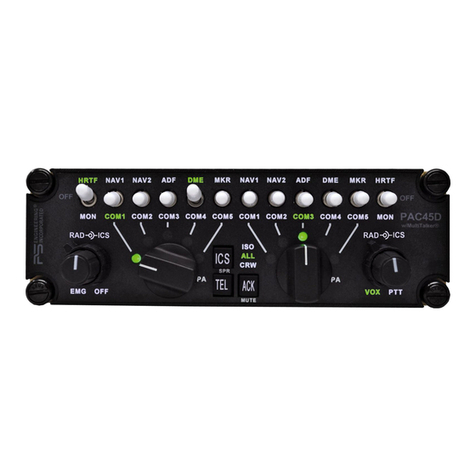
PS Engineering
PS Engineering PAC45D User guide
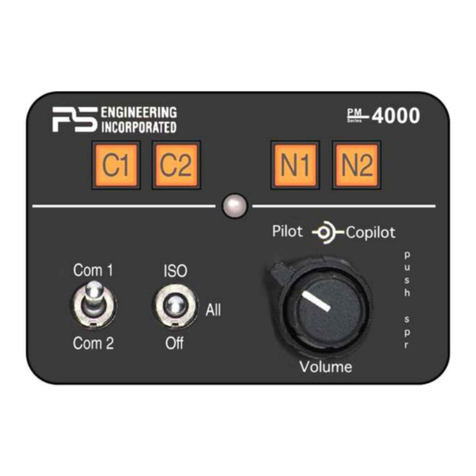
PS Engineering
PS Engineering PMA4000 TSO User manual
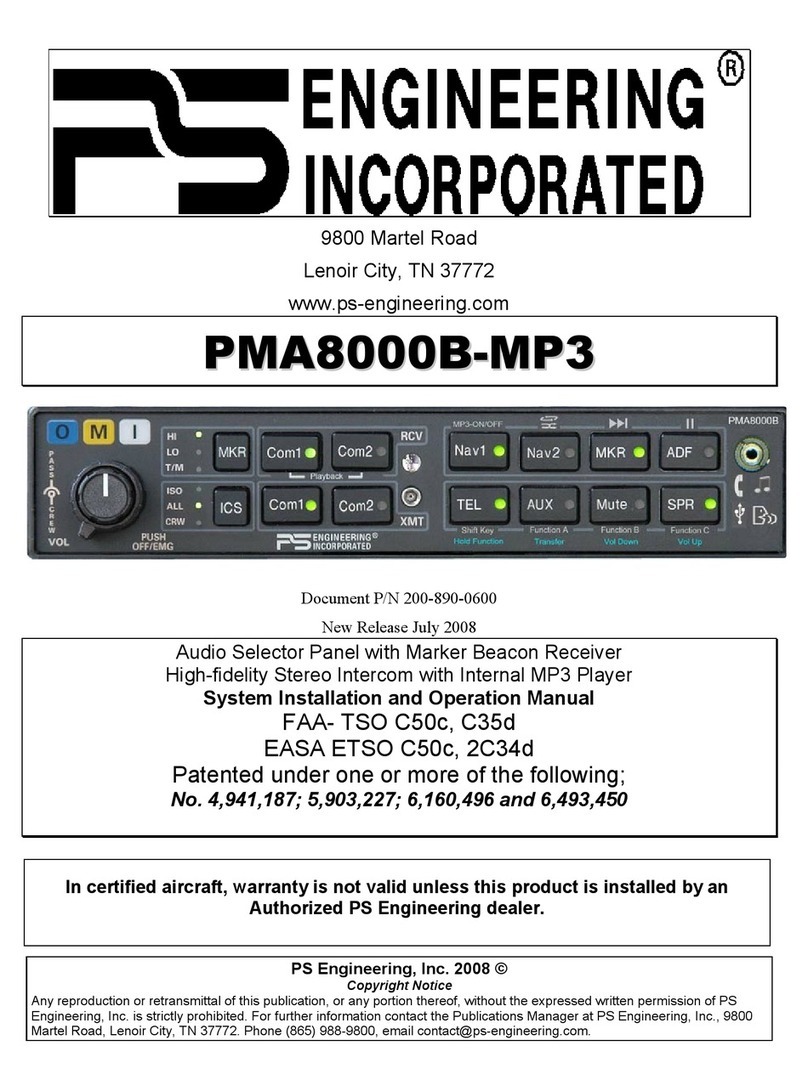
PS Engineering
PS Engineering PMA8000B--MP3 User manual

PS Engineering
PS Engineering PMA8000G User guide
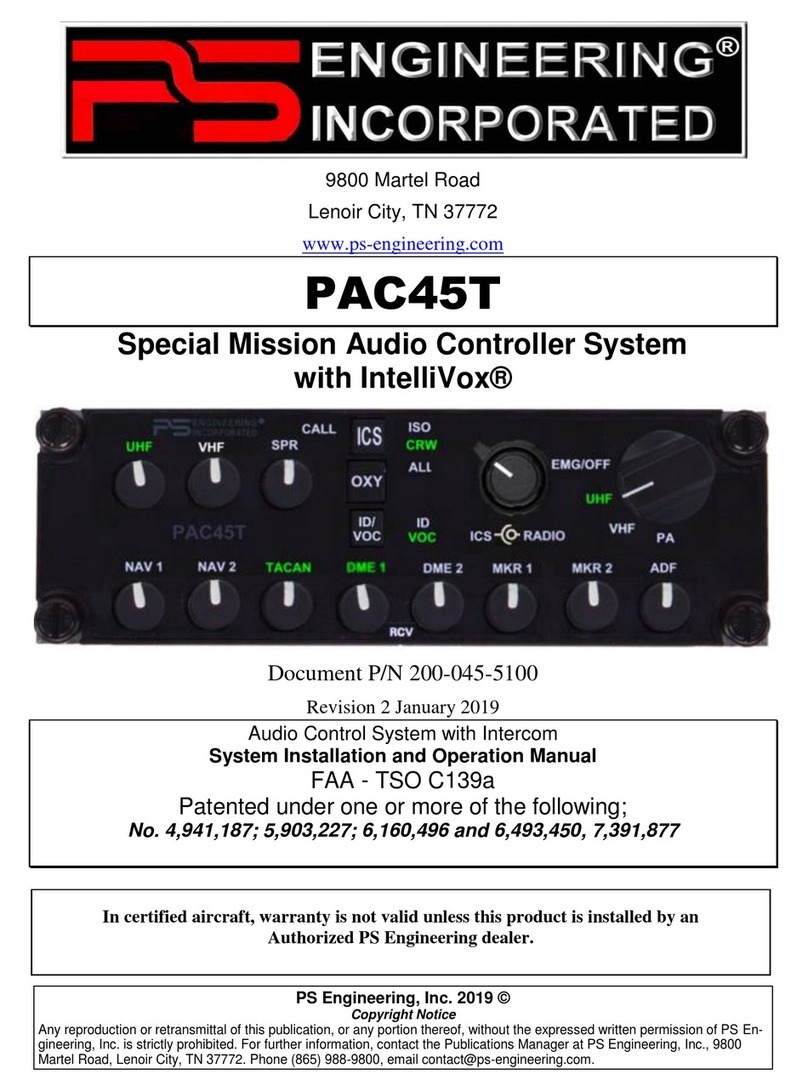
PS Engineering
PS Engineering PAC45T User guide
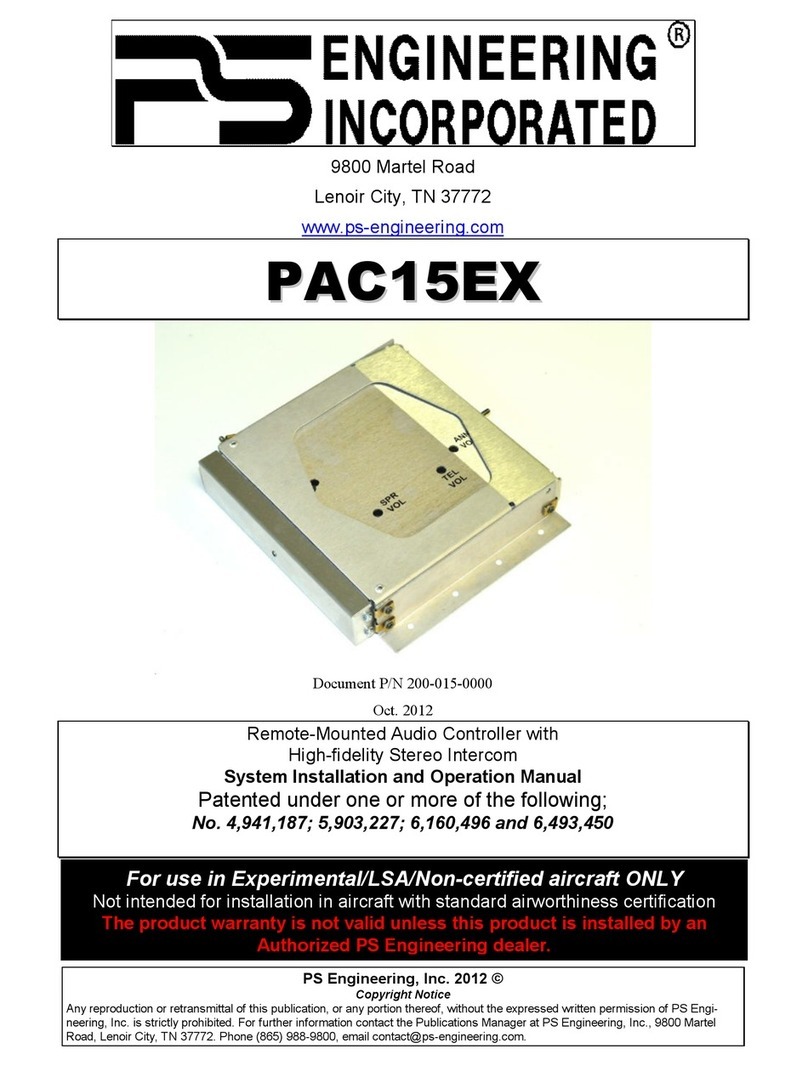
PS Engineering
PS Engineering PAC15EX User guide
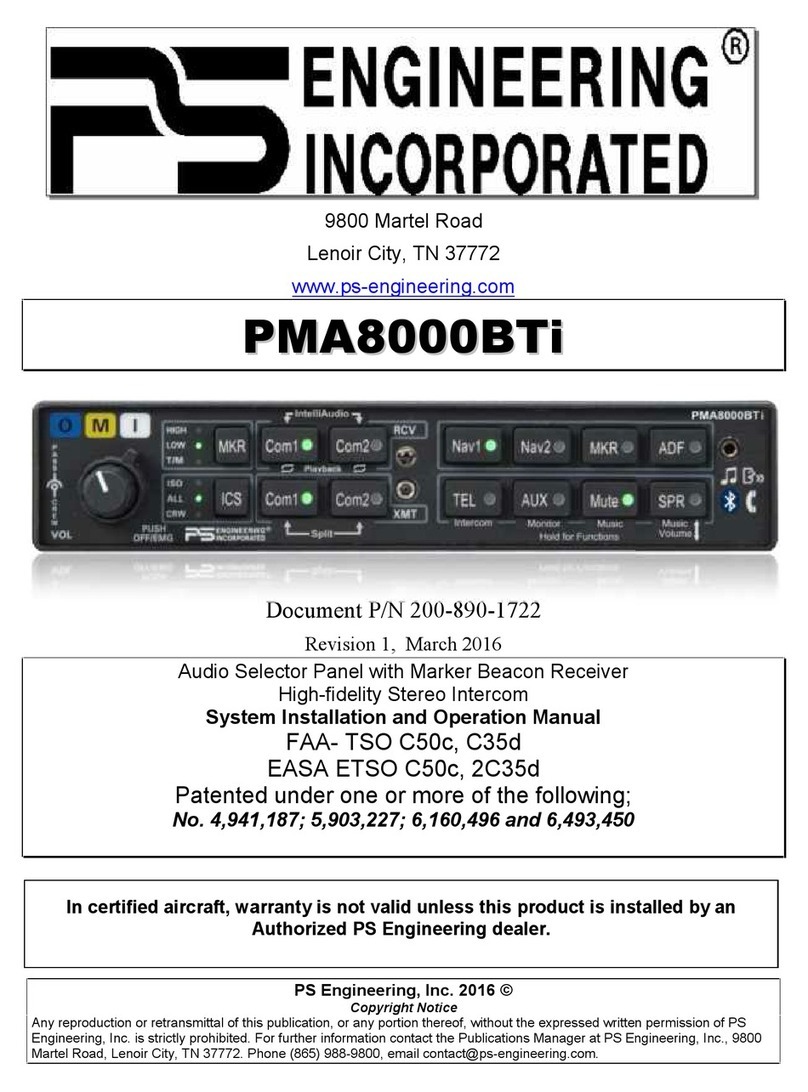
PS Engineering
PS Engineering PMA8000BTi User manual
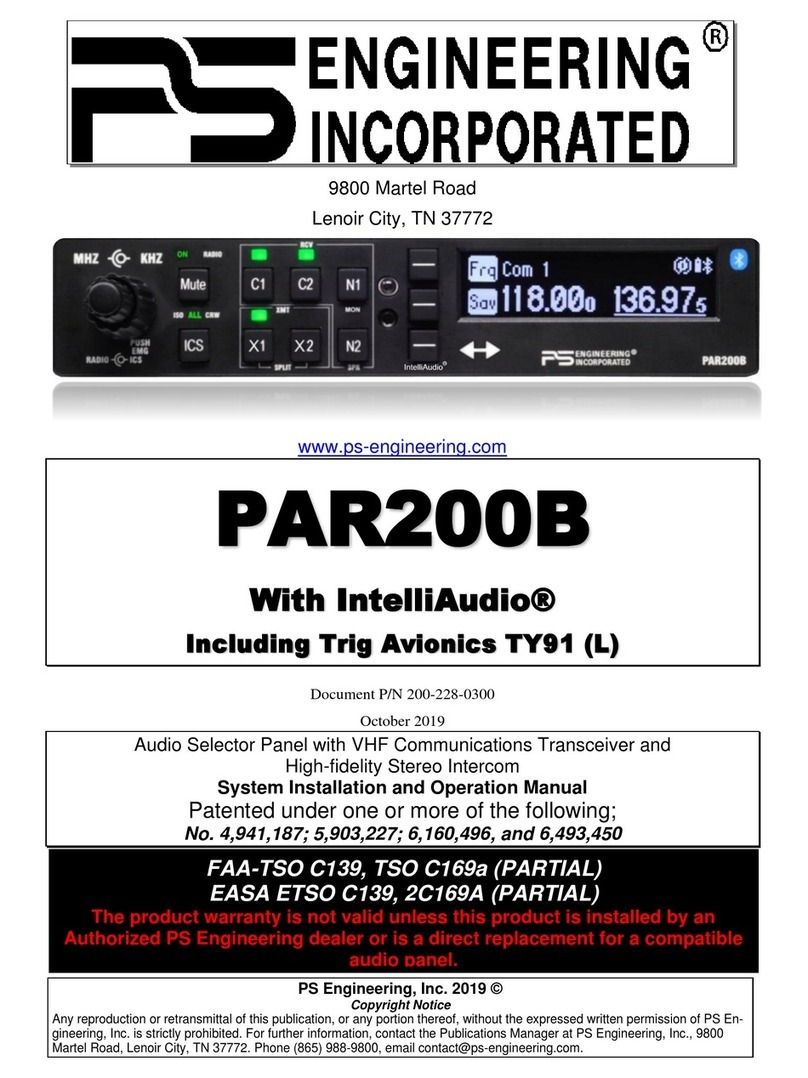
PS Engineering
PS Engineering PAR200B User guide

PS Engineering
PS Engineering PMA8000B--MP3 User manual
